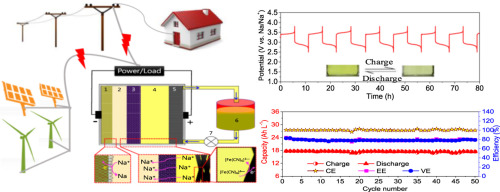Energy Efficient Na-Aqueous-Catholyte Redox Flow Battery
- Journal
- Energy Storage Materials
- Vol
- 12
- Page
- 324-330
- Year
- 2017
Redox flow battery (RFB) technologies have become play a significant role in the future for the storage of electrical energy produced from intermitted renewable energies such as solar, wind, and hydroelectric powers. Although the development of high-energy density RFB remains a challenging. Herein, we report the Na-aqueous-catholyte RFB (NaAqRFB) towards high-density electrical energy storage. Na-metal anode offers a high energy density and the use of an aqueous flowing catholyte decouples the energy and power. NASICON (Na3Zr2Si2PO12) is employed as a solid electrolyte in the NaAqRFB to separate the Na anode and a flowable aqueous catholyte. The constructed prototype NaAqRFB operates using a sodium-hexacyanoferrate solution as the aqueous catholyte with no added supporting salt/electrolyte, and yielded an average cell potential of ∼3.06 V (vs. Na/Na+), and an energy density of 54.16 Wh L−1 (based on the volume of catholyte) with high energy efficiency (∼92%, over 50 cycles), outperforming conventional RFB. The present work offers a new route for developing high-energy-density redox flow batteries.

